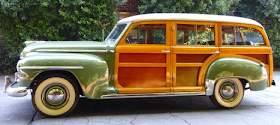Today's post features Chrysler Corporation's transition. Images below are from Chrysler or are of cars listed for sale unless otherwise noted.
1948 Plymouth DeLuxe Station Wagon
Post- World War 2 Chrysler Corporation station wagons were found only for the entry-level Plymouth brand. A likely reason is that Plymouths retained short, prewar fenders whereas all other Chrysler brands had been facelifted with front fenders extending over the front doors. Therefore, it was easier to place wooden wagon bodies on Plymouths due to no need for shaping front door wood cladding. Note the cut lines on the B-pillar and the after edge of the rear side door: these are characteristic of wood construction.
1948 Plymouth DeLuxe Station Wagon - photo via Old Cars Weekly
Showing the tailgate and other wood detailing.
1950 Plymouth Woodie Station Wagon
The entire Chrysler Corporation line was redesigned for 1949, and this 1950 model is unchanged aside from a restyled grille. Front fenders continued to shade into the front doors. Nevertheless, "Woodie" type bodies appeared on several brands. This Plymouth's rear has much less wood than on the previous station wagon. Door cut lines indicate the wooden structure. Note the curved wooden panels on the front door that allow some blending with the front fender.
1949 Plymouth Special DeLuxe Woodie Station Wagon - via Vintage Trailer Museum
A true 1949 Plymouth station wagon.
1949 Plymouth Suburban
Plymouths also received all-steel station wagon bodies for 1949 as seen here. The Suburban was a two-door car, whereas Woodie Plymouths had four doors.
1949 Plymouth Suburban
Aft quarter view.
1949 Chrysler Royal Station Wagon
The Corporation's top-level station wagon. The front door appears to be steel-clad, unlike Plymouth's Woodies.
1951 DeSoto Station Wagon - Barrett-Jackson auction photo
By 1951, Chrysler Corporation station wagons were all-steel. Areas that appear wooden are actually steel covered by decals to provide a Woodie appearance.
1951 Chrysler Windsor Town and Country Station Wagon - photo source unknown
Here is a Chrysler with the same body as the DeSoto station wagon -- but lacking the fake wood.









The 1949 Plymouth brochure only has the four door woody. The 1950 has both the woody and the two door metal wagon. The 1951 has two two door metal wagons and no woody.
ReplyDeleteProbably the metal two door came out later in 1949. I'm guessing it was way cheaper than the woodie and outsold it by a huge margin. That's all I remember ever seeing, and there seemed to be a lot of them around for a long time. The otherwise identical Dodge wagons aren't entirely identical, to make things more oddly complicated.